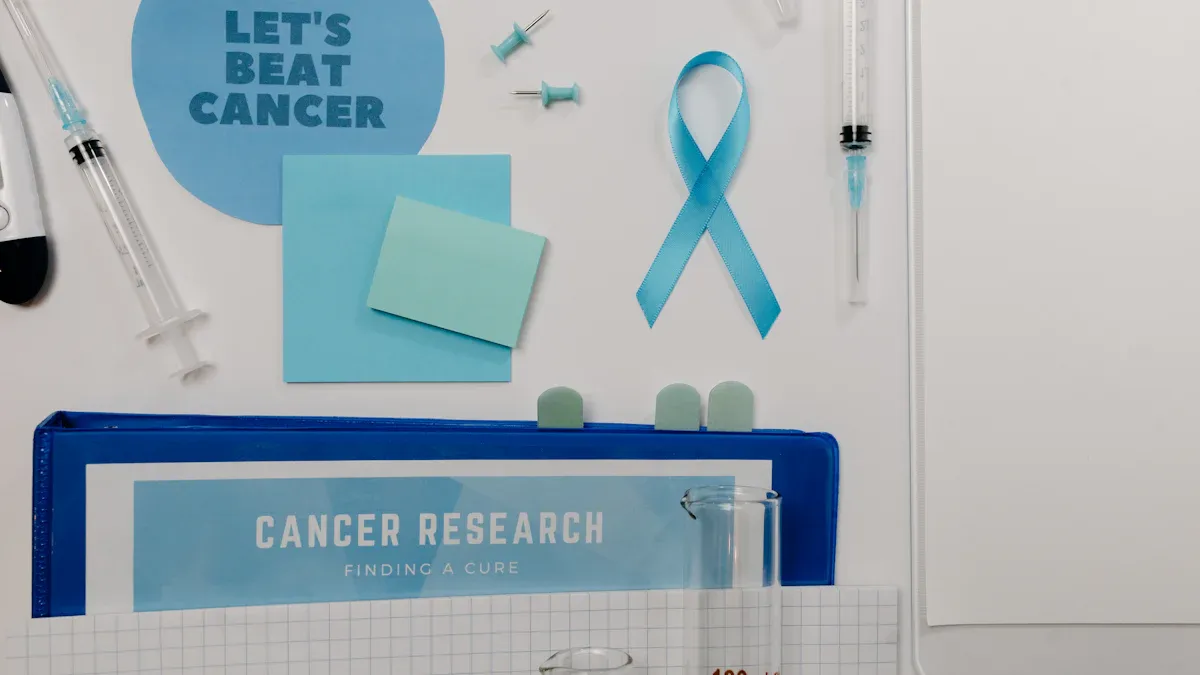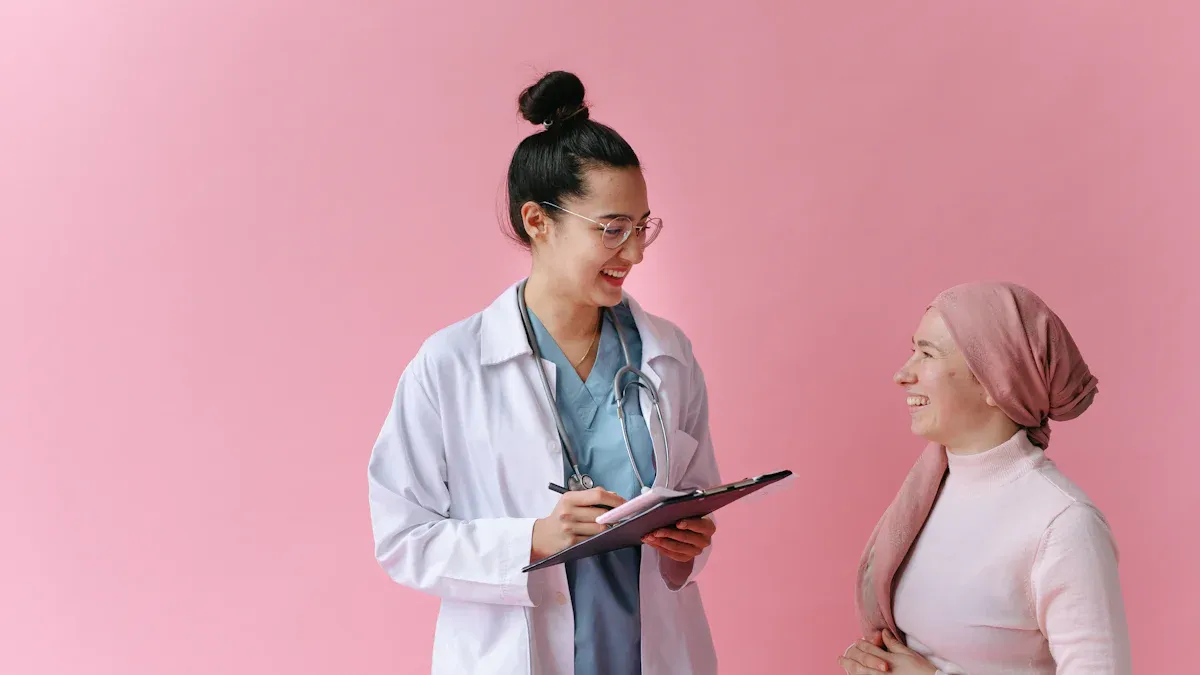How Healthcare Professionals Drive Early Cancer Detection

You might not realize it, but healthcare professionals play a crucial role in early cancer detection, serving as your strongest allies in catching cancer early. They utilize their skills to spot warning signs and guide you toward timely screenings. Did you know that general practitioners (GPs) are particularly important in this process? Their ability to recognize symptoms and refer patients quickly can make all the difference. Early diagnosis often means better survival rates. In fact, studies show that the timing of detection directly impacts outcomes for many cancers. This underscores the significance of the role of professionals in early cancer detection and highlights the importance of the relationship between you and your doctor. It’s a partnership that saves lives.
Key Takeaways
Doctors play a big role in finding cancer early. Regular visits to your doctor can help with early tests.
Finding cancer early helps people live longer. Early-stage cancer often has better treatments and results.
Knowing your risks helps your doctor choose the right tests. Talk to your doctor about your health and family history.
Tools like CT scans and genetic tests help find cancer early. These tools give more accurate results and better care for patients.
Finding cancer early saves money and is easier to treat. Early treatment costs less and is less painful, improving life quality.
The Role of Professionals in Early Cancer Detection

Primary Care Providers as the First Line of Defense
Recognizing early symptoms and warning signs
Primary care providers (PCPs) are often your first point of contact when something feels off. They’re skilled at spotting subtle symptoms that might indicate cancer, like unexplained weight loss, persistent fatigue, or unusual lumps. Their ability to connect these dots quickly can lead to earlier diagnoses. Studies show that timely referrals from general practitioners (GPs) significantly improve survival rates. This makes their role in early cancer detection absolutely vital.
Assessing risk factors and screening eligibility
Your PCP doesn’t just look at symptoms—they also consider your personal risk factors. They’ll ask about your family history, lifestyle, and any previous medical conditions. This helps them determine if you’re eligible for screenings like mammograms or colonoscopies. Public health initiatives encourage you to visit your PCP if you notice concerning symptoms. This proactive approach ensures that you get the right tests at the right time.
Multidisciplinary Collaboration in Cancer Care
Coordination between oncologists, radiologists, and other specialists
Cancer care isn’t a one-person job. It involves a team of specialists working together. Your PCP might coordinate with oncologists, radiologists, and pathologists to ensure you get the best care. Multidisciplinary teams (MDTs) are considered the gold standard in cancer care. They improve outcomes by facilitating communication and timely decision-making. For example, MDTs in Australia have shown measurable success in enhancing patient care.
Case discussions and personalized treatment planning
MDTs don’t just share information—they also discuss your case in detail. This allows them to create a treatment plan tailored to your needs. Whether it’s surgery, chemotherapy, or radiation, every decision is made with your unique situation in mind. This collaborative approach ensures you receive the most effective care possible.
Educating Patients on Early Detection
Raising awareness about cancer symptoms
You might not always know what to look for when it comes to cancer symptoms. That’s where healthcare professionals step in. They educate you about warning signs like changes in moles, persistent coughs, or unusual bleeding. Programs that mail stool tests or HPV kits directly to your home have also increased screening rates for colorectal and cervical cancers.
Encouraging timely medical consultations
Healthcare providers emphasize the importance of acting quickly. If you notice something unusual, don’t wait. Early detection often means less invasive treatments and better outcomes. Patient navigation programs, which include follow-up calls and home visits, have made it easier for people to access screenings. These efforts highlight the critical role of professionals in guiding you toward early detection.
Tools and Resources for Early Cancer Detection

Diagnostic Guidelines and Protocols
Standardized screening and diagnostic procedures
Standardized guidelines are essential for ensuring consistent and accurate cancer detection. For example, national referral pathways in the UK have been developed to promote earlier diagnoses. These pathways help healthcare providers identify high-risk patients and prioritize urgent referrals. Studies show that implementing these guidelines has improved detection rates and reduced the time it takes to diagnose certain cancers. Screening programs for cervical, breast, and colorectal cancers have also been highly effective. They’ve significantly lowered the number of late-stage diagnoses, giving patients a better chance at successful treatment.
Reducing diagnostic errors through evidence-based practices
Evidence-based practices play a key role in reducing diagnostic errors. By following established protocols, healthcare professionals can make more accurate decisions. For instance, modern imaging techniques like CT scans and mammograms are now standard tools for detecting lung and breast cancers. These methods, combined with computer-assisted diagnostics, improve the evaluation of medical images. This approach ensures that cancers are caught earlier, when they’re easier to treat.
Advanced Diagnostic Technologies
Imaging tools like CT scans, MRIs, and mammograms
Advanced imaging tools have revolutionized early cancer detection. Technologies like CT scans, MRIs, and mammograms allow doctors to spot abnormalities that might otherwise go unnoticed. For example, molecular imaging tools such as PET scans provide detailed insights into cellular activity. These advancements enhance both sensitivity and specificity, making it easier to detect cancer in its earliest stages. Innovations like the 10.5T MRI are pushing the boundaries even further, offering unparalleled clarity in imaging.
Biomarkers and genetic testing for early detection
Biomarkers and genetic testing are game-changers in cancer care. Biomarkers reveal critical information about cellular changes, helping doctors identify cancer before symptoms appear. Recent breakthroughs in detecting cancer-specific mutations in cell-free DNA have made early diagnosis more precise. Genetic testing also helps assess your risk for certain cancers, enabling you to take preventive measures. These tools empower both patients and providers to act sooner, improving outcomes.
Referral Systems and Communication Platforms
Streamlining patient referrals between providers
Efficient referral systems ensure you get the care you need without unnecessary delays. Enhanced communication between primary care providers and specialists improves the flow of information. This coordination helps prioritize urgent cases and reduces the time it takes to start treatment. In the UK, initiatives like urgent referral pathways have led to higher detection rates and better outcomes for patients.
Leveraging electronic health records for continuity of care
Electronic health records (EHRs) are vital for maintaining continuity of care. They allow healthcare providers to track your medical history, test results, and treatment plans in one place. EHRs also improve documentation and coding, which benefits both patients and healthcare systems. For example, a rural family practice saw a 10% increase in case mix and over $100K in additional revenue after adopting EHRs. These systems ensure that no detail is overlooked, making early detection efforts more effective.
The Impact of Early Detection on Patient Outcomes
Improved Survival Rates
Early-stage cancers are more treatable
When cancer is caught early, your chances of survival increase dramatically. Early-stage cancers are often localized, meaning they haven’t spread to other parts of the body. This makes them much easier to treat. For example, 57% of patients with lung cancer survive for five years or longer when diagnosed at Stage I. However, this drops to just 3% when diagnosed at Stage IV. Early detection gives you the best shot at effective treatment and long-term survival.
Examples of cancers with high survival rates when detected early
Some cancers have particularly high survival rates when caught early. For instance:
The overall cancer death rate in the U.S. has decreased by 33% since 1991. This decline is largely due to advancements in early detection, better treatments, and reduced tobacco use.
Improved screening methods, like mammograms and colonoscopies, have made it possible to catch cancers earlier, leading to better treatment results.
Reduced Treatment Burden
Less invasive treatments for early-stage cancers
Catching cancer early often means you’ll need less aggressive treatments. For example, early-stage cancers may only require surgery or localized therapies, avoiding the need for chemotherapy or radiation. This not only reduces the physical toll on your body but also shortens recovery times. Early detection allows you to maintain a better quality of life during and after treatment.
Lower healthcare costs for patients and systems
Early detection doesn’t just save lives—it also saves money. Studies show that treating cancer at an early stage is far less expensive than treating advanced-stage cancers. For instance, the cost of treating Stage I colorectal cancer is around $129,645, while Stage IV treatment costs can soar to $271,216. Similarly, patients with Stage I breast cancer face out-of-pocket costs of $8,979, compared to $11,348 for Stage IV. By catching cancer early, you can avoid the financial strain of more intensive treatments.
Enhanced Quality of Life
Better physical and emotional outcomes for patients
Early detection can make a huge difference in how you feel during and after treatment. Less invasive treatments mean fewer side effects, allowing you to stay active and maintain your daily routine. Emotionally, knowing that your cancer was caught early can reduce stress and anxiety, giving you peace of mind as you move forward with your care.
The role of follow-up care in maintaining long-term health
After early detection and treatment, follow-up care plays a key role in keeping you healthy. Regular check-ups and screenings help ensure that the cancer hasn’t returned and allow your healthcare team to address any lingering side effects. This ongoing care supports your physical and emotional well-being, helping you live a healthier, happier life.
Healthcare professionals are your strongest allies in the fight against cancer. They play a vital role in recognizing symptoms, coordinating care, and using advanced tools to ensure accurate diagnoses. Their efforts save lives by catching cancer early, when it’s most treatable. Research shows that early detection improves survival rates, especially for cancers like cervical, breast, and colorectal. For example, effective screening programs have reduced advanced-stage diagnoses, giving patients a better chance at recovery.
Early detection also lightens the treatment burden. Patients diagnosed at Stage I often face lower out-of-pocket costs—around $8,979 compared to $11,348 for Stage IV. Additionally, those with early-stage cancer experience fewer disruptions to their daily lives, with a median time to employment reduction of 14.7 months versus just 4.3 months for metastatic cancer.
To support healthcare professionals in this critical role, continued investment in training, resources, and technology is essential. By working together, you and your healthcare team can make early detection a powerful tool in improving outcomes and enhancing quality of life.
FAQ
What are the most common symptoms of cancer I should watch for?
You should look out for unusual changes in your body, like unexplained weight loss, persistent fatigue, or lumps. Other signs include changes in moles, prolonged coughs, or unusual bleeding. If something feels off, don’t ignore it—schedule a check-up with your doctor. 🩺
How often should I get screened for cancer?
It depends on your age, family history, and risk factors. For example:
Breast cancer: Mammograms every 1-2 years starting at 40-50.
Colorectal cancer: Screenings begin at 45.
Ask your doctor for personalized advice based on your health profile.
Can lifestyle changes reduce my cancer risk?
Absolutely! You can lower your risk by:
Eating a balanced diet.
Exercising regularly.
Avoiding tobacco and limiting alcohol.
These small changes make a big difference in keeping you healthy. 🌱
Are genetic tests worth considering for cancer risk?
Yes, if you have a family history of cancer. Genetic tests can reveal inherited risks, helping you take preventive steps. Talk to your doctor to see if testing is right for you. It’s a proactive way to stay ahead of potential health issues.
What should I do if I’m nervous about cancer screenings?
It’s normal to feel nervous, but remember: early detection saves lives. Talk to your doctor about your concerns. They’ll explain the process and help you feel more comfortable. Think of it as an investment in your health and peace of mind. 😊
See Also
Recognizing Duodenal Cancer: Symptoms And Treatment Options
Identifying Conjunctival Melanoma: Key Symptoms And Care
Extrahepatic Bile Duct Cancer: A Simple Explanation
Essential Information About Embryonal Carcinoma You Should Know
